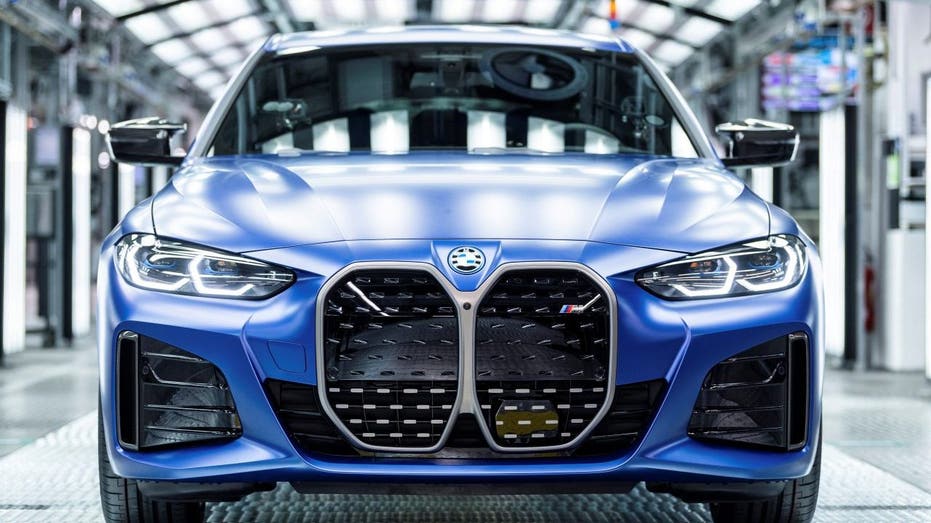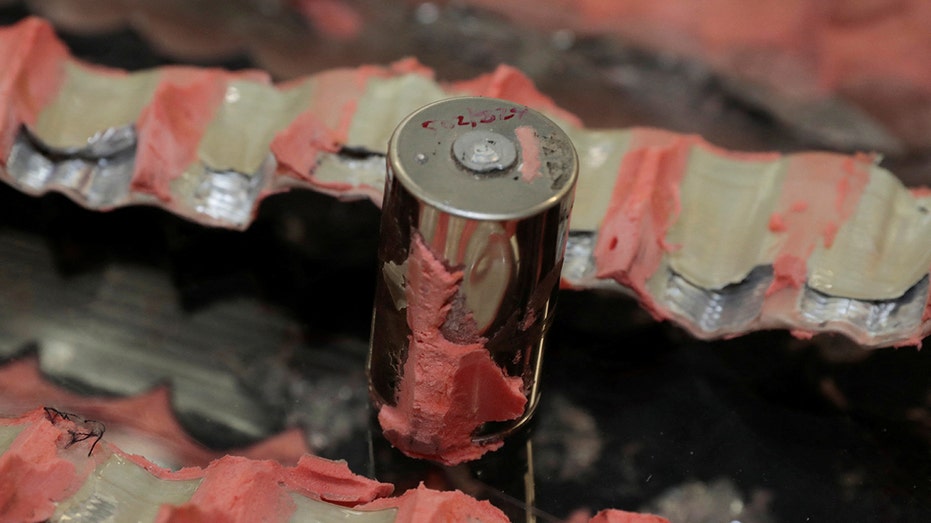Stellantis, BMW in talks with Panasonic over new EV battery plants
Cylindrical batteries used by Tesla get a closer look from other car makers
Kodak capitalizes on coating technology, enters EV battery sector
Eastman Kodak CEO Jim Continenza discusses the iconic film brand's foray into the electric vehicle battery business on 'The Claman Countdown.'
Stellantis NV and Bayerische Motoren Werke AG are talking to Panasonic Holdings Corp. about teaming up to build electric-vehicle battery plants in North America, people familiar with the talks said.
Panasonic specializes in cylindrical batteries, which resemble an oversize version of the AA batteries commonly used in consumer devices. Over the past decade, Japan-based Panasonic has churned out billions of cylindrical cells for its main car-making customer, Tesla Inc.
Car and battery makers are spending tens of billions of dollars to build capacity for EV batteries and making choices on technology now that could shape the future of the industry. One choice is between cylindrical batteries and the rectangular pouch or prismatic shapes preferred to date by most legacy auto makers.

A BMW i4 Electrical car is seen during a visit of the German Economic and Climate Protection Minister at the BMW plant in Munich, Germany, January 20, 2022. REUTERS/Lukas Barth/File Photo (Reuters Photos)
Cylindrical batteries tend to be smaller, meaning that thousands need to be strung together to power a vehicle. That can raise costs and the potential for manufacturing defects. On the flip side, the cylindrical type can pack more power and is seen as relatively safe.
EV BATTERIES LACK REPAIRABILITY LEADING SOME INSURERS TO JUNK WHOLE CARS AFTER EVEN MINOR COLLISIONS
Panasonic and others are working on larger versions of cylindrical batteries that have caught the attention of car makers, said Ram Chandrasekaran, who until last month led road-transportation research at Wood Mackenzie.
"Recent interest shows we’re at a time in the evolution of EV technology where cylindrical cells work pretty well," Mr. Chandrasekaran said.

A Tesla 4680 cell from a structural battery pack pulled from a Tesla Model Y, built in Austin, Texas, is displayed in Auburn Hills, Michigan U.S. March 3, 2023. (REUTERS/Rebecca Cook / Reuters Photos)
Stellantis, whose brands include Chrysler and Jeep, has said it plans to make an announcement about a third North America EV battery factory during the current April-June quarter. It has already started building two—one with LG Energy Solution Ltd. in Canada and another in Indiana with Samsung SDI Co.
| Ticker | Security | Last | Change | Change % |
|---|---|---|---|---|
| STLA | STELLANTIS NV | 10.65 | 0.00 | 0.00% |
Stellantis is talking to Panasonic as a possible partner for the third factory, said people familiar with the discussions, although they cautioned that discussions are at an early stage and issues remain to be worked out.
FORD CEO REVEALS EV REALITY: AMERICA 'CANNOT CONTINUE TO IMPORT' BATTERIES, EARTH MINERALS
Panasonic manufactured around 7% of all EV batteries deployed in 2022, behind Contemporary Amperex Technology Co.’s 37% and LG Energy’s 14%, according to SNE Research.
In Tesla’s early days, the EV maker and its battery supplier, Panasonic, mainly did business with each other. More recently, Tesla has begun sourcing from other Asian battery manufacturers in addition to Panasonic, and Panasonic executives have said they want to broaden the company’s customer base. In December, Panasonic said it had struck a deal to supply batteries to EV maker Lucid Group Inc.
| Ticker | Security | Last | Change | Change % |
|---|---|---|---|---|
| TSLA | TESLA INC. | 430.14 | -0.03 | -0.01% |
| LCID | LUCID GROUP INC. | 12.58 | -1.05 | -7.70% |
Recently the Japanese manufacturer has been planning an expansion in the U.S. and working on a more powerful cylindrical cell. Panasonic’s 4680 battery, which is 46 millimeters in diameter and 80 millimeters high, is larger than cells it has supplied to Tesla, and Elon Musk has touted the larger size as the key to unlocking lower-cost EVs.

Workers marry the body structure with the battery pack and the front and rear sub frames as they assemble electric vehicles at the Lucid Motors plant in Casa Grande, Arizona, U.S. September 28, 2021. Panasonic supplies batteries to Lucid Motors for t (Reuters Photos)
In addition to Stellantis, Panasonic’s batteries have drawn the attention of BMW.
Last year, BMW said its new class of EVs to be released from 2025 would use large cylindrical batteries instead of the rectangular prismatic ones that it used in previous models. On a recent earnings call, BMW executives cited cost savings, improvements in vehicle range and faster charging as reasons for the shift.
BMW has said it plans to build six new EV battery plants in Europe, China and the North America free-trade area that includes the U.S., Canada and Mexico. The company said in September it had awarded contracts in the "two-digit billion-euro range" to Chinese battery suppliers CATL and Eve Energy Co. to build two factories each in China and Europe.
The following month, BMW said it would source batteries in the U.S. from Envision AESC, a unit of Chinese renewable energy company Envision Group.
More recently, political tensions have made it difficult for Chinese battery makers to operate in the U.S. That is one reason BMW is talking to Panasonic, according to people familiar with the companies.
Peter Lamp, BMW’s head of battery-cell technology, said the company was in talks with potential suppliers for additional battery projects but no contracts had been signed. He declined to name specific companies.
Mr. Chandrasekaran, the transport analyst, said the technology behind the rectangular-shaped batteries was also advancing and there wasn’t likely to be a single winner soon.

Elon Musk and another Tesla executive talk to an audience about their cylindrical battery design. (Getty Images)
BYD Co., a Chinese maker of both batteries and EVs, has developed a prismatic model it calls a blade battery that contains long, flat blade-like cells slid into a battery pack. BYD says the structure maximizes use of space and energy density.
GET FOX BUSINESS ON THE GO BY CLICKING HERE
Mr. Chandrasekaran said auto makers would likely stick to prismatic batteries for certain vehicle types such as lower-cost, moderate-performance models.




















